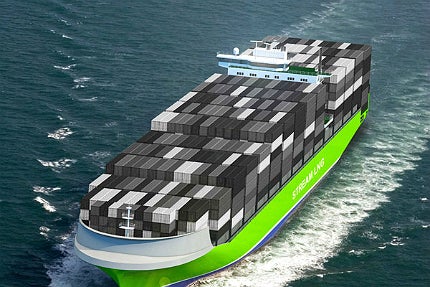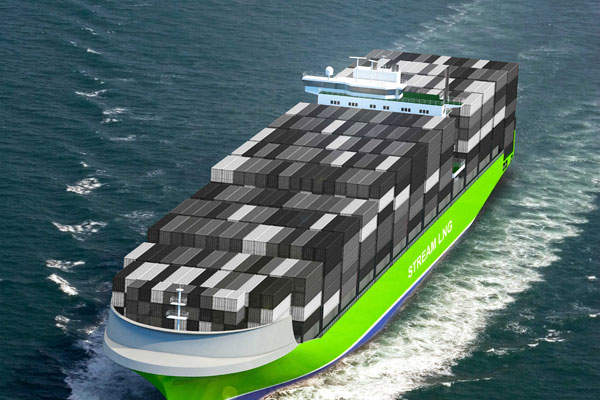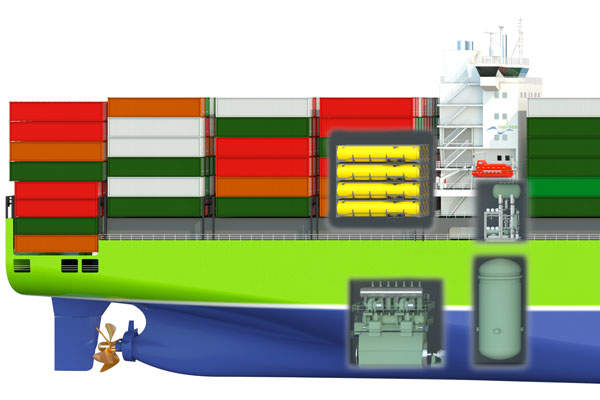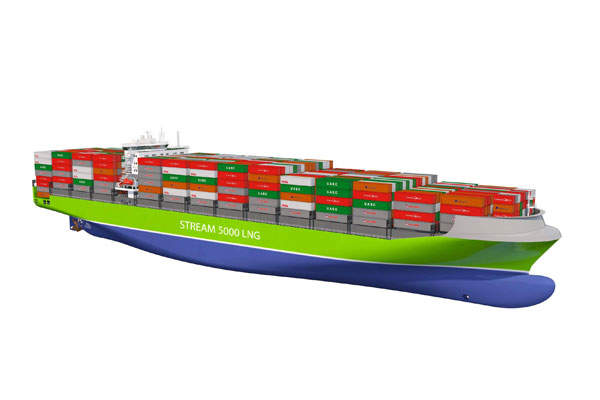
STREAM 5000 LNG is a new generation container vessel designed by Ingenieur Partner Pool (IPP) according to TECHNOLOG’s concepts. The licence for the design of the vessel is owned by TECHNOLOG.
The vessel design received the Approval in Principle (AiP) certificate from GL in September 2012.
Licences for the construction of the vessel were sold to SUMEC Marine Company in April 2013. The company is now promoting the STREAM design for construction at the top shipyards in Jiangsu Province.
The vessel’s design meets all future requirements set forth by International Maritime Organization (IMO). The vessel will be capable of saving more than 500,000t of CO2 emissions in the course of its lifecycle and also reduce emissions of nitric oxide and sulphur oxide gases based on LNG fuel properties.
The acronym for STREAM stands for sustainable transport, reliable, economic and ambitious. The vessel will carry the class notations + 100 A5 CONTAINER SHIP, HATCHCOVERLESS, DG, IW, ERS, HLP, BWM, NAV-OC, MC, AUT, RCP, GF, EP.
The container vessel will be capable of sailing on both heavy fuel oil (HFO) and liquefied natural gas (LNG).
STREAM 5000 vessel dimensions and design
The vessel is designed with an overall length of 249.8m, a moulded breadth of 37.4m, a maximum draught of 13.4m and a maximum deadweight of about 61,400t with a container intake of nominal 5,000 TEU. Up to 1,490 reefer plugs are available.
The vessel will accommodate about 28 persons in fully air-conditioned rooms. It will be capable of handling all ranges of container sizes. It will be a fully cellular open-top container vessel subdivided into several double 40ft holds.
All of the 40ft container slots in the hold, as well as three tiers of the deck slots, will accommodate reefer containers. Special ventilation systems will be developed to suit these refer slots. The forward hold is designed to carry dangerous goods.
LNG fuel systems of the vessel will include a fixed bunker tank inside the vessel and, if required by the operator, a portable deck-mounted LNG tank system which can be used to provide extra capacity. This system was particularly developed for smaller type of vessels such as STREAM 2100LNG and STREAM 3500LNG. The fuel storage and bunkering systems will be constructed to avoid gas spillage.
The entire vessel beneath the deck will comprise of passages, providing access to the cargo and machinery spaces and the crew’s quarters. Armoured shutter plates can be closed in the central entrance lobby to cut off the interior of the vessel, including the deck house from the deck. These arrangements will be made to provide safety to the ship’s crew from pirates.
The entire energy generation on board will be controlled by a minimum-fuel-consumption-power-management-system (MFC-PMS). The vessel will also be equipped with a waste heat recovery system (WHRS) for even greater fuel efficiency.
Deck equipment, machinery and propulsion of the LNG Container Vessel
The vessel’s deck will feature two gravity launched life saving boats, with one meant for rescue operations and two combined work boat cranes.
The deck will also be equipped with two combined anchor and mooring winches, three mooring winches on the aft, a mooring winch forward, an electro-hydraulic steering gear and warping heads.
The vessel can also be optionally fitted with electrically-operated deck cranes.
The vessel’s propulsion system will comprise of a two stroke dual fuel de-rated MAN 6S80 ME-C9.2-GI, DMCR 18,240kW, a shaft motor rated at 4kW and an FP-propeller comprising of five blades.
STREAM 5000LNG will also be equipped with auxiliary engines comprising of three dual fuel MAN Diesel gen-sets rated at 3,200kW, an emergency diesel gen-set rated at 400kW, a waste heat recovery (WHR) turbo generator rated at 1,850kW and a dual fuel boiler. The bow thrusters for the vessel will be rated at 1,500kW.
The vessel will be fitted with a low-running propeller supplied by Mecklenburger Metallguss (MMG) and a rudder supplied by Becker Marine. The vessel was designed for a cruising speed of between 14kt and 18.5kt and possesses a top speed of 21.5kt.
Key players involved with the new generation container vessel
The design of the cargo storage and lashing equipment as well as the stack splitting system were carried out in co-operation with CARGOTEC. TGE Marine Gas Engineering was involved in providing the design of the LNG fuel systems.
Hamburgische Schiffbau-Versuchsanstalt (HSVA) and GL’s FutureShip were involved in providing their expertise in software tools utilising computational fluid dynamics (CFD), to generate hull forms with improved hydrodynamic properties.
They also provided solutions to minimise the vessel’s fuel consumption, as well as resistance in water and air, while maximising its cargo capacity.
Related content
Horizon Spirit Container Ship, United States of America
Horizon Spirit is a C9 class container ship owned by Horizon Lines. The vessel was commissioned in 1980.
Toisa’s Multipurpose Offshore Construction Vessel (MOCV), South Korea
Toisa, a marine services provider, contracted Hyundai Heavy Industries (HHI) in February 2013, to construct a multipurpose offshore construction vessel (MOCV) based on the X-Bow hull design.










